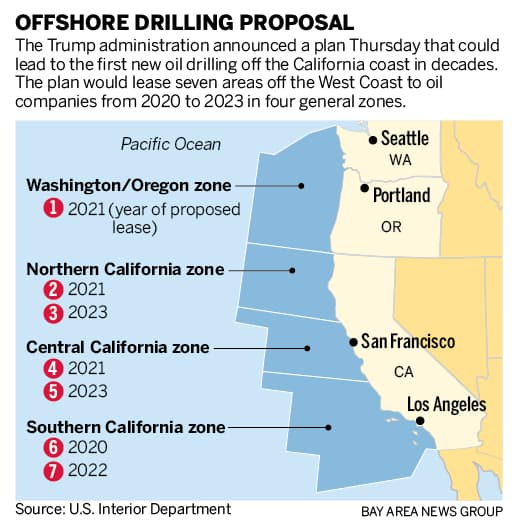Administration Moves to Open Offshore Drilling off California and Florida
The Trump administration announced a major policy shift on November 20, 2025, unveiling plans to allow federal offshore oil leasing in areas off California and Florida that have not been leased in decades. The move, justified by officials as advancing U.S. energy security and “energy dominance”, immediately provoked bipartisan state opposition and raised questions about environmental, economic and legal fallout for coastal communities.

The Trump administration on November 20 announced a plan to open new federal offshore oil leasing in portions of the outer continental shelf off California and Florida, marking a significant reversal of longstanding de facto limits on drilling in those waters. Officials framed the decision as a step toward greater U.S. energy security and “energy dominance”, and said the initiative would create jobs and expand domestic supply of fossil fuels.
The administration provided a broad timeline for lease sales and said it would pursue environmental reviews required under federal law before moving forward. The Department of the Interior is expected to lay out specific sale dates, prepare environmental impact statements and carry out the public comment and consultation processes that typically accompany major offshore leasing decisions. The announcement emphasized the administration’s political defense of the plan amid mounting public concern about climate change and coastal protections.
Reaction from state leaders and stakeholders was swift and largely negative. California and Florida officials, representing constituencies reliant on tourism and coastal industries, issued bipartisan statements warning of long term ecological harm and economic risk to beaches, fisheries and waterfront businesses. Environmental organizations and coastal tourism stakeholders signaled they would mobilize both public opposition and legal challenges, arguing that expanded drilling jeopardizes marine ecosystems and undermines efforts to reduce greenhouse gas emissions.
In Congress, initial responses reflected the fault lines the announcement has exposed. Some lawmakers praised the emphasis on domestic energy and job creation, while many others warned that the policy conflicts with national climate commitments and coastal economic interests. The administration’s plan is expected to be the immediate focus of hearings and legislative maneuvering as members of both parties seek to shape or block the proposed lease sales.
Policy analysts note several institutional implications. The decision will place added pressure on the Interior Department to produce robust environmental analyses that can withstand legal scrutiny. It also raises questions about coordination with state regulators and existing federal statutes governing offshore development, including how state based coastal management concerns will be reconciled with federal leasing authority. Insurance markets and local governments that depend on tourism revenues will monitor potential impacts on coastal property values and fiscal stability.
The administration’s timetable and the content of forthcoming environmental reviews will determine the near term trajectory of the policy. If lease sales are scheduled, they will trigger rounds of permit reviews, potential litigation and political mobilization at the state and local levels. For communities along the California and Florida coastlines, the announcement crystallizes a conflict between short term economic arguments for expanded oil production and longer term environmental and economic risks tied to climate change and coastal resilience.
The debate over the new offshore leasing plan is likely to shape legislative, regulatory and courtroom battles in the months ahead, testing the balance between federal energy policy objectives and pressures from states, local economies and environmental advocates.


